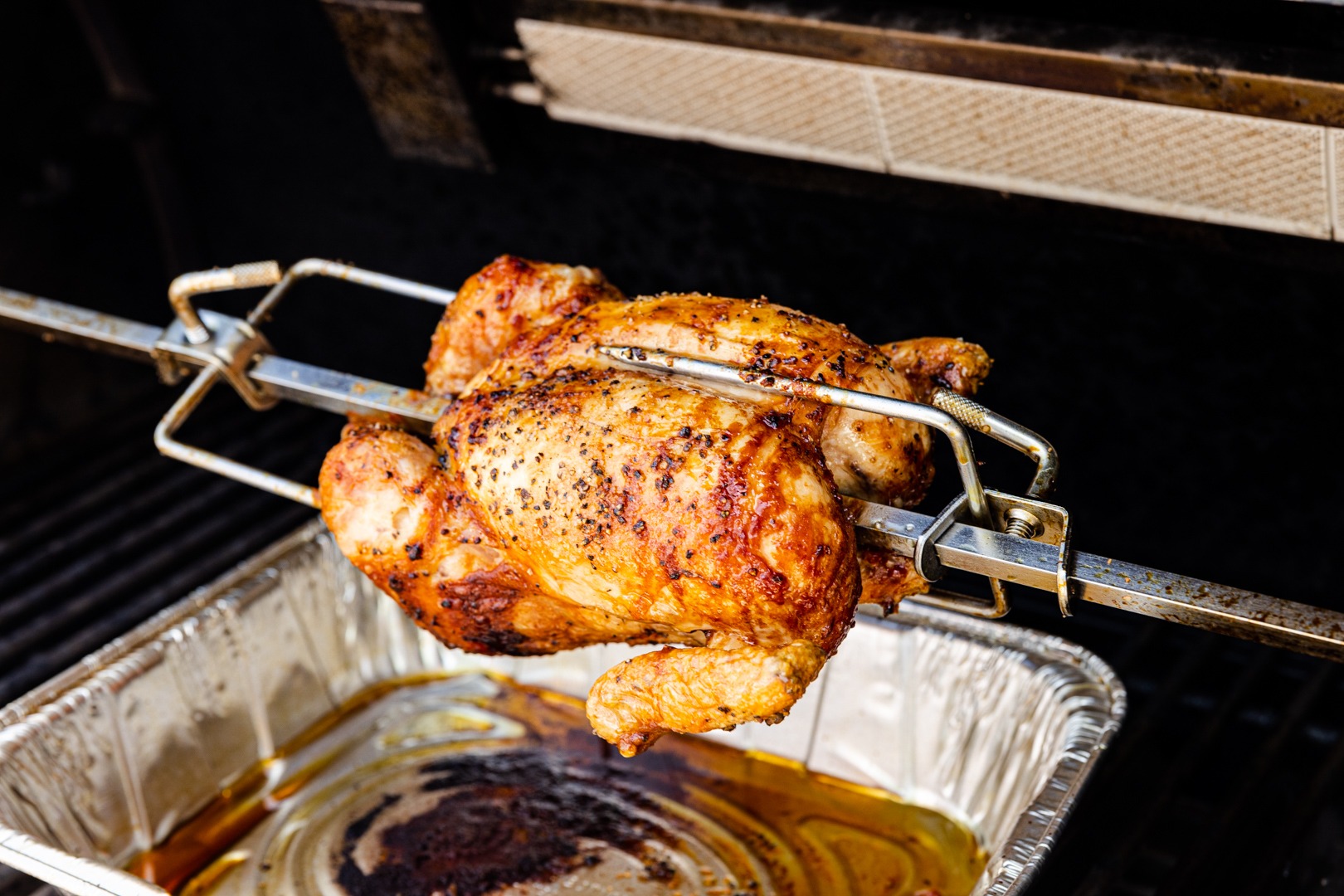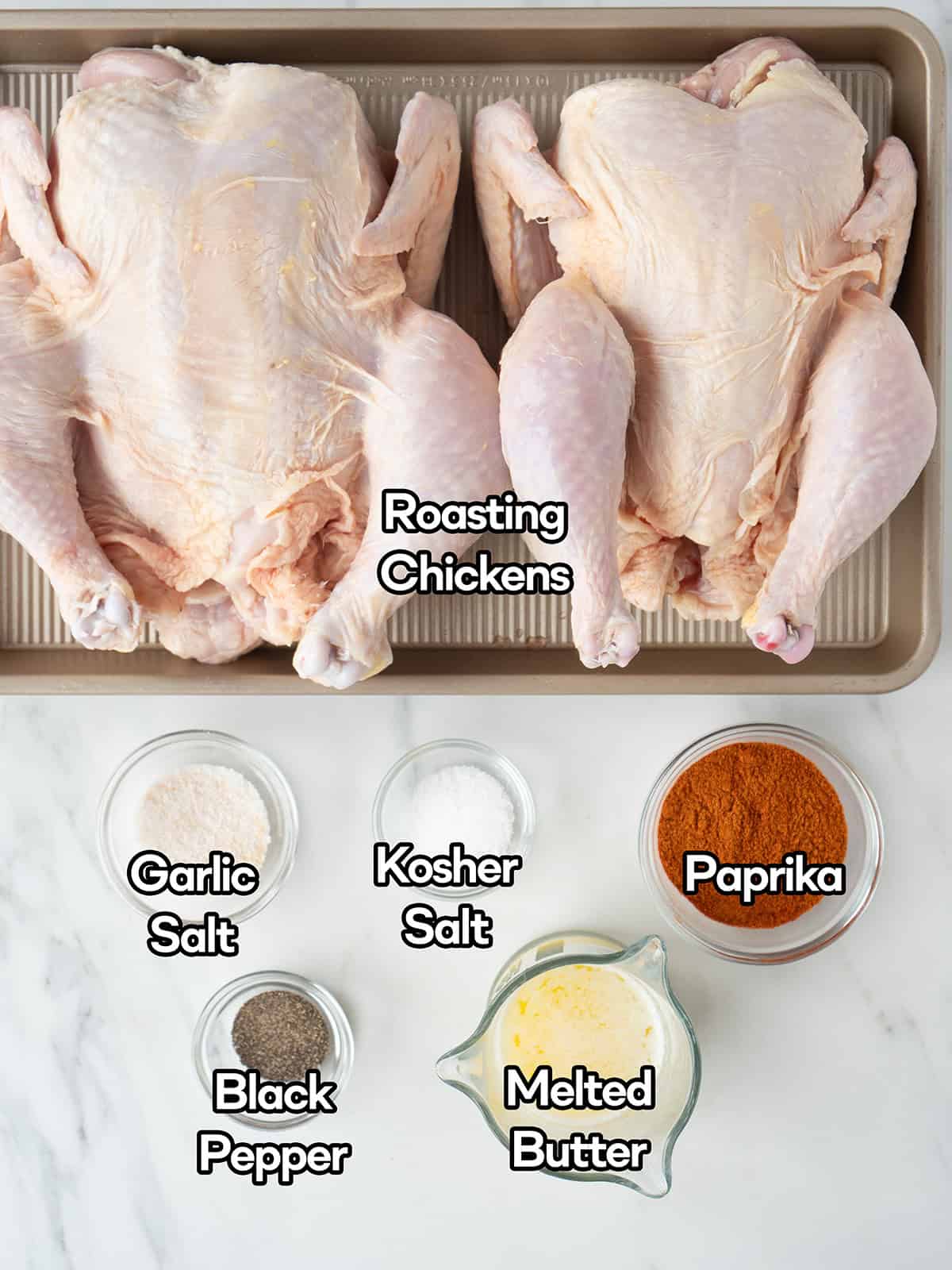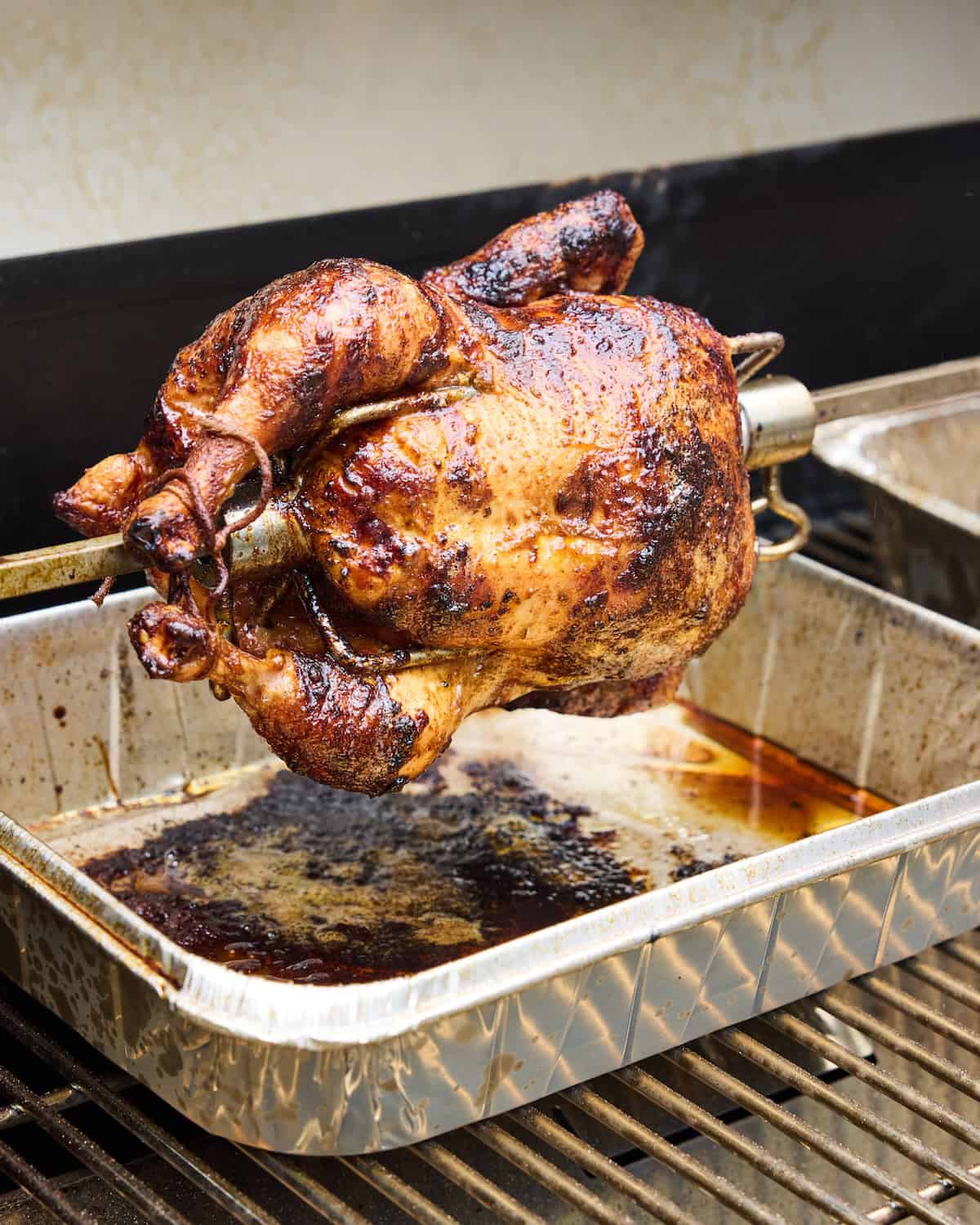Hey there, fellow food lovers! I’ve been obsessing over making the perfect rotisserie chicken at home lately, and let me tell ya – getting the temperature right is THE game-changer! After tons of trial and error (and a few dry birds I’d rather forget about), I’ve finally cracked the code on what temperature to rotisserie a chicken for that juicy, tender meat and crispy, golden skin we all dream about.
Whether you’re using a fancy pellet grill, a standard gas grill with a rotisserie attachment, or even a countertop rotisserie oven, I’m gonna break down everything you need to know about temperatures, timing, and testing for the ultimate homemade rotisserie chicken experience.
Why Temperature Matters for Rotisserie Chicken
Before diving into the exact temps, let’s understand why getting the temperature right is so crucial
- Safety first! Chicken needs to reach a safe internal temperature to kill harmful bacteria
- Juiciness factor – correct cooking temps keep the meat moist and tender
- That crispy, golden skin – the right temperature creates that gorgeous exterior
- Even cooking – proper temps ensure both white and dark meat cook perfectly
Getting the temperature wrong can result in either unsafe chicken (yikes!) or a dry, disappointing dinner. Nobody wants that!
The Ideal Cooking Temperature for Rotisserie Chicken
After reviewing several expert sources and many cooking experiments, here’s what I’ve found about the ideal cooking temperatures for rotisserie chicken:
External Cooking Temperature (Grill/Oven Temperature)
There seems to be a bit of variation in recommendations, but here’s the consensus:
- 375°F to 400°F – The most commonly recommended temperature range
- 300°F to 350°F – Some sources recommend this slightly lower range for extra juiciness
- Initial high heat (500°F) then reduced to 350°F – A two-phase approach some chefs recommend
In my experience, I’ve had the best results starting around 400°F for the first 10-15 minutes to get the skin browning process going, then reducing to 350°F for the remainder of the cooking time. This gives me that crispy skin while keeping the meat juicy.
Internal Temperature (Chicken Doneness)
While external temperature varies, there’s absolute agreement on the required internal temperature:
- 165°F (74°C) – The USDA-recommended safe internal temperature for chicken
- 157°F (69°C) – Some experts recommend pulling white meat at this temperature, as it will continue to rise during resting (though the USDA officially recommends 165°F)
- 175°F (79°C) – Dark meat (thighs and legs) is often better at this higher temperature
As one expert source notes, “White meat is best cooked to a pull temp of about 157°F (69°C) so that it doesn’t dry out, but thigh and leg meat is better around 175°F (79°C) or higher.”
Temperature Tips for Different Rotisserie Methods
Depending on what equipment you’re using, you may need to adjust your approach:
Gas Grill with Rotisserie Attachment
- Preheat the entire grill on high for about 15 minutes
- Turn off center burners (directly under the chicken)
- Set outside burners to medium/medium-high
- If you have a rotisserie burner, use it for just the first 10 minutes then shut it off
Pellet Grill with Rotisserie
- Preheat to 500°F
- After about 25 minutes of cooking, reduce to 350°F
- Baste every 15 minutes with seasoned butter for extra flavor and moisture
Countertop Rotisserie Oven
- Most countertop units work best between 375°F to 450°F
- Always follow your specific model’s instructions
- These smaller units often cook faster, so check temperatures earlier
Charcoal Grill
- Set up for indirect heat (coals on both sides, no coals directly under chicken)
- Aim for a temperature around 375°F to 475°F
- Use a drip pan underneath to catch drippings
The Temperature Dilemma: White Meat vs. Dark Meat
Here’s one of the trickiest parts of rotisserie chicken – dark meat and white meat prefer different cooking temperatures! The breast meat is best at a lower temperature than the thighs and legs.
I found this brilliant tip to help solve this problem: ice the breasts before cooking!
By placing ice packs or bags of ice on the chicken breasts for about 30 minutes before cooking, you create a temperature differential between the parts of the bird. The breast meat starts cooler, so it reaches its ideal temperature at roughly the same time the dark meat reaches its higher ideal temperature.
One expert explains: “By letting the chicken sit on the counter with a bag of ice on the breasts for a half-hour or so before you cook, you allow the thigh meat to come up to a warmer temperature while maintaining a colder breast temp.”
How Long to Cook a Rotisserie Chicken
While temperature is the most important factor, here’s a general timeframe to expect:
- 12-15 minutes per pound – A good starting guideline
- About 60-75 minutes – Total cooking time for a typical 4-5 pound chicken
- 90 minutes – For larger birds or lower cooking temperatures
Remember, these are just guidelines! The actual cooking time depends on:
- The size of your chicken
- Your specific grill/oven
- The actual temperature inside your cooking device
- Whether you brined or marinated the chicken
- Weather conditions (if cooking outdoors)
Always use a meat thermometer to check for doneness rather than relying solely on time.
Testing for Doneness: The Right Way
PLEASE don’t rely on the “juices run clear” method! It’s not reliable. Here’s how to properly test if your rotisserie chicken is done:
- Turn off the rotisserie motor
- Use a fast and accurate instant-read thermometer
- Insert the thermometer into the thickest part of the breast (without touching bone)
- Check that it reads at least 165°F (or 157°F if you’re comfortable with carryover cooking)
- Also check the thickest part of the thigh, aiming for 175°F
- If temperatures aren’t reached, continue cooking and check again in 5-10 minutes
I’ve found that a good digital thermometer is absolutely essential for perfect rotisserie chicken. It’s the only way to truly know when your chicken is perfectly done.
My Favorite Rotisserie Chicken Temperature Hack
Here’s my personal secret to amazing rotisserie chicken: the two-temperature method. I start cooking at a higher temperature (around 400-425°F) for the first 15-20 minutes to get that skin browning process going, then I drop the temperature down to 350°F for the remainder of the cooking time.
This approach gives me the best of both worlds – crispy, golden skin AND juicy, tender meat. I’ve tried cooking at a single temperature the whole time, and while it works okay, this two-phase approach really elevates the results.
Troubleshooting Common Temperature Issues
Even with the right temperature knowledge, things can go wrong. Here are solutions to common problems:
Problem: Skin is burning but chicken isn’t done inside
Solution: Your temperature is too high. Lower the heat and consider using indirect heat if you’re not already.
Problem: Chicken is taking forever to cook
Solution: Your temperature is likely too low. Increase the heat and make sure your thermometer is accurate.
Problem: Outside is done but inside isn’t safe yet
Solution: Cover the chicken with foil to prevent further browning and continue cooking until safe internal temperature is reached.
Problem: Dark meat is done but white meat is overcooked
Solution: Try the ice-pack trick next time to create a temperature differential before cooking.
Final Temperature Tips for Rotisserie Chicken Success
Before I wrap up, here are my top temperature tips for rotisserie chicken perfection:
- Always use a good thermometer – This is non-negotiable for perfect results
- Let it rest – After reaching proper temperature, let the chicken rest for 10 minutes before carving
- Consider a butter baste – Basting with seasoned butter every 15-20 minutes helps regulate surface temperature and adds flavor
- Monitor your grill/oven temperature – External temperatures can fluctuate, so keep an eye on it
- Remember carryover cooking – The chicken’s internal temperature will rise 3-5°F after removing from heat
Nailing the perfect temperature for rotisserie chicken takes a bit of practice, but it’s so worth it! The store-bought rotisserie chickens just can’t compare to a homemade version where you control the quality of the chicken, the seasonings, and most importantly, the cooking temperature.
I recommend aiming for an external cooking temperature of 375-400°F and cooking until the breast meat reaches 165°F and thigh meat reaches 175°F. Use the ice-pack trick to help balance the cooking between white and dark meat, and always use a good thermometer to check for doneness.
What’s your experience with rotisserie chicken? Have you found a temperature trick that works particularly well? Drop a comment below – I’d love to hear about your successes (or hilarious failures)!
Happy rotisserie cooking!

Why I Love This Recipe
Growing up my dad would make Rotisserie Chicken at least twice a month on the weekends. It was always a special night when hed bring the chickens to the table, perfectly carved and my mom would make a cucumber salad and some rice or pasta. Its my dream weekend meal and NOW I can do it myself! I recently got a Pellet Grill which is truly heaven. I know many of us think Pellet Grills can be intimidating but Im here to tell you that it legit couldnt be easier.
First, you can hook it up to your phone if you want to keep and eye on temp while youre inside. Second, the flavor that comes from pellet grilling is exceptional. This rotisserie chicken blows all store-bought chickens out of the water and it was beyond easy. Dont mind me, just recreating my childhood favorite one day at a time over here!

- Paprika – Sub smoked paprika for deeper flavor, or chili powder for a little extra kick.
- Garlic salt – You can also mix garlic powder with sea salt.
- Freshly cracked black pepper – Add a little crushed red pepper for a spicier twist.
- Roasting chickens (4 pounds each) – Or, a bone-in turkey breast for a bigger crowd
- Butter – Olive oil for a lighter option.
*For a full list of ingredients and instructions please see recipe card below

Is rotisserie chicken healthy or unhealthy?
Rotisserie chicken can be a super healthy choice, as it is a good source of lean protein and its being cooked on a rotisserie rather than in oil.
Simple Steps to the Perfect Rotisserie Chicken | Weber Grills
FAQ
What temperature do you cook a rotisserie chicken to?
To cook rotisserie chicken, aim for an oven or grill temperature between 325°F and 375°F (160°C and 190°C). Cook until the internal temperature in the thickest part of the thigh reaches 165°F (74°C), using a meat thermometer for accuracy. Resting the chicken for at least 10 minutes after cooking will allow the temperature to rise to the safe 165°F and keep the meat juicy.
Is it better to roast chicken at 350 or 400?
Is whole chicken done at 165 or 180?
According to the USDA, chicken needs to reach 165° for safety. For texture, dark meat is better at 180°-185°, and breast meat is good at 165°. You are cooking to a final internal temperature, never by time alone. So, you must use an instant-read thermometer.
What is the secret to juicy rotisserie chicken?
Create a Moist Environment. Adding water to the bottom of the roasting pan will create steam and moisture, keeping the chicken super juicy.
